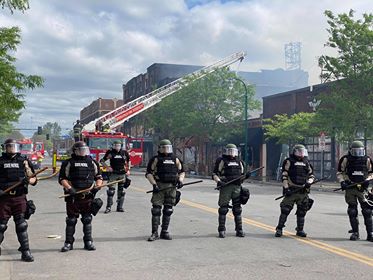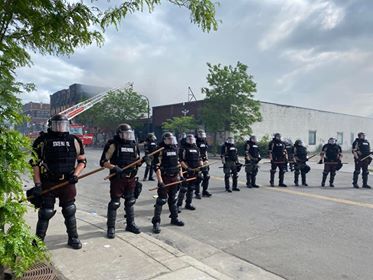
- Details
- By Darren Thompson
MINNEAPOLIS — Migizi Communication, a 40-year-old American Indian youth organization, was set on fire early Friday morning in Minneapolis as the city continues to be ravaged by protests that have turned into rioting.
Yesterday was the third day of violence in Minneapolis after the death of George Floyd, a 46-year-old African American man, who died as the result of excessive police force.
Migizi’s building, which was purchased late 2018, at 3017 South 27th Avenue in Minneapolis was not targeted but caught fire at approximately 5 a.m. Friday morning as the result of the fire spreading from an adjacent five-story building.
The American Indian Movement patrolled the city last night to monitor buildings that house American Indian businesses, organizations and programs in the Twin Cities.
 Minnesota State Police stand guard as firefighter contain fire at Migizi. Native News Online photograph by Darren Thompson.
Minnesota State Police stand guard as firefighter contain fire at Migizi. Native News Online photograph by Darren Thompson.
From early reports, Migzi was not targeted. A nearby building, El Nuevo Rodeo, was initially set on fire, but the fire spread to the entire block on South 27th Avenue.
“I was there until the area was deemed unsafe. We had youth, parents and the American Indian Movement patrolling our organization. We were the only organization on the block that remained untouched during the riots,” Binesikwe Means, Migizi’s social media team lead, told Native News Online on Friday morning outside the burned building. “The building that housed El Nuevo Rodeo started on fire and it eventually took over the whole block.”
Fortunately, archives that date back to 1977 were saved by staff.
Migizi, an Ojibwe word for bald eagle, acts as a circle of support that nurtures the development of Native American youth in order to unleash their creativity and dreams – to benefit themselves, their families and community, according to the organization’s website. A unique youth center because since 1977 its purpose has been to train young journalists to counter stereotypes of American Indians in the media.
It has evolved into a program that teaches multimedia for Native youth aimed at providing state-of-the-art storytelling skills, enhancing self-esteem and improving academic performance. Additional MIGIZI efforts address youth needs in jobs, culture, leadership and more.
This summer the program was slated to engage with 50 youth.
An estimate of the damage sustained by the building has not been determined at press time.
This is a developing story.
Levi Rickert contributed to this story from Grand Rapids, Michigan.
More Stories Like This
Native News Weekly (August 25, 2024): D.C. BriefsUS Presidents in Their Own Words Concerning American Indians
NDAA passes House; Lumbee Fairness Act Advances
NFL, Vikings to Host Native All-American Game, Youth Flag Clinic
Senate Committee on Indian Affairs Passes 12 Bills to Strengthen Tribal Communities
Help us defend tribal sovereignty.
At Native News Online, our mission is rooted in telling the stories that strengthen sovereignty and uplift Indigenous voices — not just at year’s end, but every single day.
Because of your generosity last year, we were able to keep our reporters on the ground in tribal communities, at national gatherings and in the halls of Congress — covering the issues that matter most to Indian Country: sovereignty, culture, education, health and economic opportunity.
That support sustained us through a tough year in 2025. Now, as we look to the year ahead, we need your help right now to ensure warrior journalism remains strong — reporting that defends tribal sovereignty, amplifies Native truth, and holds power accountable.
 The stakes couldn't be higher. Your support keeps Native voices heard, Native stories told and Native sovereignty defended.
The stakes couldn't be higher. Your support keeps Native voices heard, Native stories told and Native sovereignty defended.
Stand with Warrior Journalism today.
Levi Rickert (Potawatomi), Editor & Publisher
